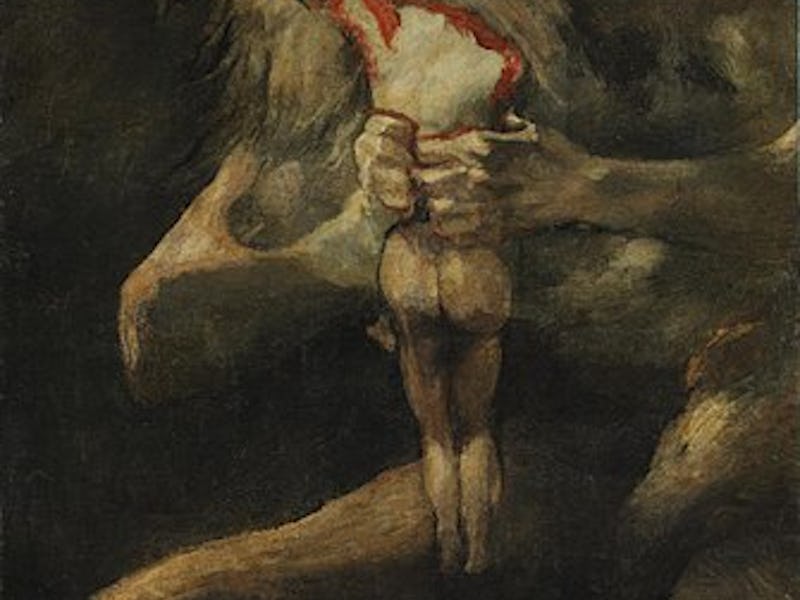Cannibalism Researchers Explain the "Perplexing" Benefit of Eating Your Kids
"We began to wonder if eating or getting rid of some young could help out remaining offspring."

Society doesn’t exactly see consuming one’s own children as an act of care. When scientists first documented filial cannibalism — the killing and eating of one’s own offspring — they were quick to label it a rare quirk of evolution. It was a tragic event that seemed maladaptive, at best. However, a study released Tuesday adds to a growing body of evidence that shows the opposite. Eating kids isn’t just natural — it’s sometimes the considerate thing to do.
Of course, it’s less considerate when you’re the one being eaten. But scientists explain in Frontiers in Ecology and Evolution how they used a mathematical model to prove that, in some cases, sacrificing a few children so many others can live underlies the argument that filial cannibalism is a form of parental care.
Hope Klug, Ph.D., an associate professor at the University of Tennessee at Chattanooga, tells Inverse that the team started this investigation by wondering why such a wide range of animals eat or abandon their young.
“From an evolutionary perspective, this is really perplexing because if you’re always eating your babies, it’s hard to imagine how a trait like filial cannibalism or abandonment could persist in a population,” Klug says. “We began to wonder if eating or getting rid of some young could help out remaining offspring, and that’s essentially what we found.”
Frogs will often deposit their eggs in communal nesting areas — increasing the chance of cannibalism.
Bears, dogs, and mice have all been documented eating their young, and the same holds true for some birds and spiders. Filial cannibalism is especially witnessed in species that participate in communal egg laying — creatures like fish, insects, reptiles, and amphibians.
In this study, Klug and her colleagues specifically focused on these egg-laying species. Communal egg laying — when multiple members of a species share a nesting region — comes with its pros and cons. On the positive side, it makes it easier for animals to protect, clean, incubate, and feed eggs. The problem is that it also increases the chance of disease transmission and competition for food and oxygen.
Scientists have previously hypothesized that eating offspring is an adaptation that improves the overall survival of offspring because it reduces density — fewer kids mean a greater chance of more kids making it out alive. Here, the researchers tested this hypothesis with a mathematical model. The model introduced one animal with a mutation for filial cannibalism into a population of generic egg-laying animals. Klug explains that filial cannibalism is thought to be a trait that is in part controlled by one or more genes.
Then they watched what happened.
Previous models based on a similar design found that the gene for cannibalism spread throughout a population if it resulted in more calories for a parent. That’s good news for a parent, but not exactly an argument for parental care. What’s different about this study is that they found filial cannibalism served the surviving offspring: More eggs resulted in more cannibalism, which in turn resulted in increased fitness. The children born from the cannibalistic parents were able to outcompete and replace the generic population.
Eastern hellbender salamanders also eat their young. Above, one is measured in an Appalachian stream.
Klug says this result was a surprise — they didn’t anticipate that filial cannibalism would improve the survival of the remaining offspring. She says we can think of this as a “thinning of the nest” — if you have so many offspring that not all of them will be able to survive, then removing some young is a beneficial act for the offspring that aren’t eaten.
For other species that eat their young, like mammals, Klug says it’s likely they eat their babies because something is wrong with them — or because they are likely to be eaten by predators. Most likely, filial cannibalism occurs across species for a range of reasons, not just because it’s a service to other offspring to eat a few when eggs are clumped together, although that is what was determined here.
“From a biological perspective, it’s really interesting that there might be a range of factors that lead to the evolutionary origin and maintenance of this behavior,” Klug explains.
Maurice Sendak’s Where the Wild Things Are famously said to their adopted child, Max, “We’ll eat you up — we love you so.” While love may not be exactly the motive in real-life wild things, they are willing to eat their young as well.
Abstract:
Parental care is a key life-history trait that increases offspring fitness. When one thinks of parental care, nurturing behaviors such as guarding, provisioning, and grooming typically come to mind. However, such conventional forms of care often co-occur with offspring abandonment or filial cannibalism (the consumption of one’s offspring). Offspring abandonment and filial cannibalism are typically viewed as evolutionary conundrums that are contradictory to parental care. Here, we hypothesize that when offspring survival is density dependent, offspring abandonment and filial cannibalism can themselves function as forms of parental care for remaining offspring. We use a mathematical model to test this hypothesis. Our results suggest that offspring abandonment and filial cannibalism can function as forms of parental care. These results have the potential to broaden our general understanding of what is considered to be parental care.